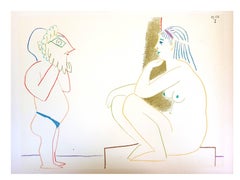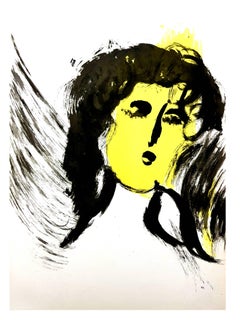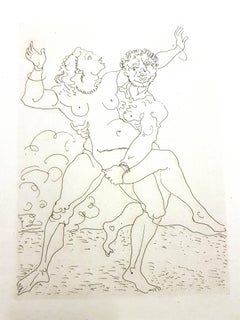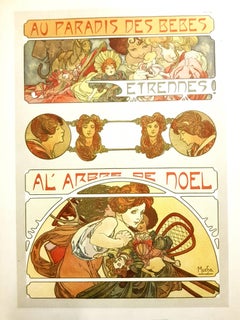Miniature Nude Prints
to
122
1,080
466
579
162
113
Overall Width
to
Overall Height
to
355
189
112
57
43
42
15
14
11
8
1
1
61
29
24
23
18
16
44
855
165
18
61
91
98
37
81
99
128
70
42
12
770
276
30
787
471
456
288
216
209
192
118
116
27
23
22
21
21
19
19
17
15
13
12
421
365
177
118
56
60
303
523
482
Size: Miniature
The Human Comedy - Lithograph
Located in Collonge Bellerive, Geneve, CH
After Pablo Picasso
The Human Comedy - Lithograph after an original drawing, as published in the journal "Verve"
Printed signature and date
Dimensions: 32...
Category
1950s Modern Nude Prints
Materials
Lithograph
Salvador Dali - Nude at the Fountain
Located in Collonge Bellerive, Geneve, CH
Salvador Dali - Nude at the Fountain - Original Etching
Dimensions: 38 x 28 cm
Edition: 235
1967
embossed signature
On Arches Vellum
References : Field 67-10 (p. 34-35)
Category
1960s Surrealist Nude Prints
Materials
Etching
Process. 2010. Paper, mixed media, 21.5x30 cm
Located in Riga, LV
Process
2010. Paper, mixed media, 21.5x30 cm
Atis Ievins (1946)
The exhibition by artist Atis Ieviņš reminds the very origins of serigraphy technique in Latvian art in the time of ...
Category
2010s Contemporary Nude Prints
Materials
Paper, Mixed Media
Marc Chagall - Woman Angel - Original Lithograph
By Marc Chagall
Located in Collonge Bellerive, Geneve, CH
Marc Chagall, Original Lithograph depicting an instant of the Bible.
Technique: Original lithograph in colours
Year: 1956
Sizes: 35,5 x 26 cm / 14" x 10.2" (sheet)
Published by: Édit...
Category
1950s Modern Figurative Prints
Materials
Lithograph
André Derain - Ovid's Heroides - Original Etching
By André Derain
Located in Collonge Bellerive, Geneve, CH
André Derain - Ovid's Heroides
Original Etching
Edition of 134
Dimensions: 32 x 25 cm
Ovide [Marcel Prevost], Héroïdes, Paris, Société des Cent-une, 1938
Andre Derain was born in 1880 in Chatou, an artist colony outside Paris. In 1898, he enrolled in the Academie Carriere in Paris where he met Matisse. He attended art school and in 1900, set up a studio with Maurice deVlaminck. After his military service from 1900-1904, Derain exhibited his work at the Salon des Independants and then at the Salon d'Automne with Matisse, Vlaminck and others, thus creating the movement of Fauvism.He worked with Henri Matisse in 1905 at Collioure, and participated in the 1905 Salon d’Automne with Matisse, Vlaminck, and Braque, the exhibition in which this group was labeled as Fauves, or Wild Beasts. Along with Vlaminck, Derain was one of the first artists to collect the tribal art of Africa which was influential to many of the artists of the early 20th century.
In 1906, Derain met Picasso and his dealer, who purchased Derain's entire studio, creating newfound financial success. During this time, he was hired for the illustrations for works by Guillaume Apollinaire and Andre Breton. After World War I, his friend's Cubism movement affected his art, along with influence from Classicism and African Art.
Derain stayed in Paris during most of the Occupation, where he was esteemed by the Nazis because of his artistic integrity. Hitler's Foreign Minister commissioned him to paint a family portrait, but he politely refused. His popularity began to decline after the war because of disagreement over new artistic movements. He later lost most of his eyesight due to illness, which may have been the reason he was hit by a truck in 1954, dying from shock at the age of 74.
Derain’s Fauve paintings are typically bright with intense color. Influenced by the work of Cézanne as well as the early Cubist paintings of Picasso and Braque’s, Derain’s style changed and by 1912, the paintings became more traditional and structured. For the remainder of his career, he continued to investigate different compositional methods including the perspective of Cézanne and the pointillism of Seurat. He also designed ballet sets and made a number of sculptures.
At the turn of the century, Andre Derain exhibited at the radical Fauve Salon d’Automne (1905) and was one of the founding members of the Fauvist movement together with his life-long friends Matisse and Vlaminck. The works he produced in this period, often under the guidance of Matisse, have been counted among the masterpieces of Fauvism.
From around 1918, Derain turned his back on the avant-garde and had begun to explore some of the more traditional genres of Western art, including landscapes. His main source of inspiration once the Fauves group had dispersed was found in the Louvre, where he admired the early Renaissance works in particular. Talking of his frequent visits there, he once said, ‘That seemed to me then, the true, pure absolute painting.’ His work evolved through many styles and, most significantly, turned back to the past, particularly after 1922 when Lenin had publicly pronounced his disdain for abstract art.
Derain built up an immense and fascinating collection of paintings, sculpture and objets d’art throughout his life which aided his experimentation and was reflected in his work between 1930 and 1945. During these years, his painting technique displayed the most avenues of invention, using a repertoire of primitivist motifs. His eclectic collection was constantly changing. In 1930 he sold his African collection in exchange for bronzes of antiquity and the Renaissance which indicated a real change of interest in the objects, as did his later pursuit of Greek ceramic painting and his enthusiasm for grand cycles of literary and antique themes...
Category
1930s Modern Nude Prints
Materials
Etching
Alfons Mucha - Original Lithograph - Christmas Baby Party
Located in Collonge Bellerive, Geneve, CH
Title: Decorative Documents
Author: Alfons Mucha.
Publisher: Paris: Librairie Centrale des Beaux-Arts, 13 Rue Lafayette. Emile Levy publisher. Published ...
Category
Early 1900s Art Nouveau Nude Prints
Materials
Lithograph
Jacques Villon - Sleeping Nude - Original Etching
Located in Collonge Bellerive, Geneve, CH
Jacques Villon - Sleeping Nude - Original Etching
Circa 1950
Signed in pencil
Edition of 45.
Dimensions : 32.7 x 25 cm
Category
1950s Modern Nude Prints
Materials
Etching
Peace and rush
Located in Edinburgh, GB
Boris Akopian "Peace and rush"
Category
1970s Nude Prints
Materials
Paper
Salvador Dali - Jonas Salk - Original Handsigned Engraving
Located in Collonge Bellerive, Geneve, CH
Salvador Dali - Jonas Salk - Original Handsigned Engraving
Dimensions: 17.5 x 12.5 cm
1970
Signed in pencil
EA
Jean Schneider, Basel
References : Field 70-5
Category
1960s Surrealist Nude Prints
Materials
Engraving
Salvador Dali - Head of Veal - Original Etching
Located in Collonge Bellerive, Geneve, CH
Salvador Dali - Head of Veal - Original Etching
Embossed signature
From the edition of 731
Dimensions: 38,5 x 28,5 cm
1969
References : Field 69-1 / Michler & Lopsinger 305
Category
1960s Surrealist Nude Prints
Materials
Etching
Pablo Picasso (after) Helene Chez Archimede - Wood Engraving
Located in Collonge Bellerive, Geneve, CH
Pablo Picasso (after)
Helene Chez Archimede
Medium: engraved on wood by Georges Aubert
Dimensions: 44 x 33 cm
Portfolio: Helen Chez Archimede
Year: 1955
Edition: 240 (Here it is on...
Category
1950s Cubist Figurative Prints
Materials
Engraving, Woodcut
Kees Van Dongen - Les Lepreuses - Original Portfolio with 26 Lithographs
Located in Collonge Bellerive, Geneve, CH
TITLE : Les Lepreuses (text by Heny de Montherlant)
EDITOR : NRF, Paris 1946
PRESENTATION : in-4 in leaves under slipcase
ILLUSTRATION : 26 original lithographs by Kees VAN DONGEN (w...
Category
1940s Modern Nude Prints
Materials
Lithograph
André Masson - Original Lithograph
By André Masson
Located in Collonge Bellerive, Geneve, CH
Maurice Estève - Composition
Original Lithograph
1964
Dimensions: 32 x 25 cm
Revue XXe Siècle
Cahiers d'art published under the direction of G. di San Lazzaro.
French painter born...
Category
1960s Abstract Expressionist Nude Prints
Materials
Lithograph
Niki II
Located in Toronto, ON
Image Size: 11" x 13.5" Unframed
Limited Edition Giclee on Canvas Printer's Proof of 6
Hand Signed by Robert Hartshorn
Category
21st Century and Contemporary Nude Prints
Materials
Giclée
$1,950
Leonor Fini - Dancing - Original Handsigned Lithograph
By Leonor Fini
Located in Collonge Bellerive, Geneve, CH
Leonor Fini - Dancing - Original Handsigned Lithograph
Les Elus de la Nuit
1986
Conditions: excellent
Handsigned and Numbered
Edition: 230
Dimensions: 38 x 28 cm
Editions: Trinckvel...
Category
1980s Modern Nude Prints
Materials
Lithograph
Salvador Dali - The Arrival of Iseult - Original Etching
Located in Collonge Bellerive, Geneve, CH
Salvador Dali - The Arrival of Iseult - Original Etching
Dimensions: 45 x 33 cm
Edition: 125
1970
Signed in pencil.
On Arches Vellum
References : Field 70-10 (p. 60-61)
Category
1970s Surrealist Nude Prints
Materials
Etching
Salvador Dali - The Kidnapping - Original Etching on Silk
Located in Collonge Bellerive, Geneve, CH
Salvador Dali - The Kidnapping - from "Les Amours de Cassandre"
Original Etching
From the suite on Silk made for editions 9 to 34
Dimensions: 38,5 x 28,5 cm
...
Category
1960s Surrealist Nude Prints
Materials
Etching
Marc Chagall - Colorful Bible King - Original Lithograph
By Marc Chagall
Located in Collonge Bellerive, Geneve, CH
Marc Chagall, Original Lithograph depicting an instant of the Bible.
Technique: Original lithograph in colours
Year: 1956
Sizes: 35,5 x 26 cm / 14" x 10.2" (sheet)
Published by: Édit...
Category
1950s Modern Figurative Prints
Materials
Lithograph
Salvador Dali - The Giant Beliagog
Located in Collonge Bellerive, Geneve, CH
Salvador Dali - The Giant Beliagog - Original Etching
Dimensions: 45 x 33 cm
Edition: 125
1970
Signed in pencil.
On Arches Vellum
References : Field 70-10 (p. 60-61)
Category
1970s Surrealist Nude Prints
Materials
Etching
Leonor Fini - Playing - Original Handsigned Lithograph
By Leonor Fini
Located in Collonge Bellerive, Geneve, CH
Leonor Fini - Playing - Original Handsigned Lithograph
Les Elus de la Nuit
1986
Conditions: excellent
Handsigned and Numbered
Edition: 230
Dimensions: 38 x 28 cm
Editions: Trinckvel...
Category
1980s Modern Nude Prints
Materials
Lithograph
Pablo Picasso (after) Helene Chez Archimede - Wood Engraving
Located in Collonge Bellerive, Geneve, CH
Pablo Picasso (after)
Helene Chez Archimede
Medium: engraved on wood by Georges Aubert
Dimensions: 44 x 33 cm
Portfolio: Helen Chez Archimede
Year: 1955
Edition: 240 (Here it is on...
Category
1950s Cubist Figurative Prints
Materials
Engraving, Woodcut
Ossip Zadkine - Ultimate Step - Original Etching
Located in Collonge Bellerive, Geneve, CH
Etching monogrammed in the plate.
Illustration for a Robert Ganzo's poem "Lespugue"
Editions Marcel Sautier, Paris, 1966.
Conditions: Good Conditions
Dimensions: 25,5 x 16,5 cm.
Vellum paper
Référence Czwiklitzer n°55.
1890
Zadkine was born on the 14th of July in Vitebsk, a city in Belarussia, on the Dvina.
His father Ephime teaches classical languages at the local seminar.
His mother Sophie Lester descended from Scots, who emigrated at the time of Peter the Great.
1905
His parents send him to Sunderland, in the North of England, where his mother’s family lives.
He studies English and attends modelling courses at the local Art School.
1905-1909
He travels to London without his parents permission where he attends courses at the Regent Street Polytechnicum.
In order to earn his living, he plans to work with a stonecutter.
He visits the British Museum and studies classical sculpture there.
Returns to Smolensk where he produces his first sculpture.
Goes back to London.
1909-1910
Zadkine settles in Paris and studies in the ecole Nationale des Beaux-Arts.
Finds a workshop in a building called La Ruche, in the XVe arrondissement.
1911
Zadkine presents statues and drawings at the annual Salon d’Automne and at the Salon des Indépendants.
It is the ‘cubists’ who draw his attention in Paris.
Is essentially close to Russian students who get together in a cafe of the ‘Quartier Latin’.
Has himself called Joe Zadkine until 1914.
1912-1913
Finds a room in the neighbourhood of Montparnasse, in the rue de Vaugirard.
Studies Roman sculpture.
Zadkine is immortalized by his neighbour, photographer Marc Vaux, in his new workshop.
Meets Brancusi, Guillaume Apollinaire, Jacques Lipchitz, Pablo Picasso, Antoine Bourdelle, Leopold Survage and Robert Delaunay.
Henri Matisse visits Zadkine’s workshop.
1914-1915
Exhibition at the Freie Sezession in Berlin, at De Onafhankelijken in Amsterdam (Holland) and at
the Allied Artists Association in London.
Thanks to collector Paul Rodocanachi, he can settle in a workshop in the rue Rousselet.
Becomes friends with Modigliani.
1916-1917
Works as a stretcher-bearer on the front. Produces drawings and watercolours dealing with war.
Zadkine is discharged in 1917.
He says he is ‘bodily and spiritually’ ruined by the war.
After his stay in the Epernay hospital he recovers in Bruniquel, in the southwest of France.
1918-1919
Makes a series of 20 war etchings...
Category
1960s Modern Figurative Prints
Materials
Etching
Jean Gabriel Domergue - Women - Original Etching
Located in Collonge Bellerive, Geneve, CH
Original Etching by Jean-Gabriel Domergue
Dimensions: 33 x 25 cm
1924
Edition of 100
This artwork is part of the famous portfolio The Afternoon of a F...
Category
1920s Impressionist Nude Prints
Materials
Lithograph
Leonor Fini - The Cane - Original Handsigned Lithograph
By Leonor Fini
Located in Collonge Bellerive, Geneve, CH
Leonor Fini - The Cane - Original Handsigned Lithograph
Les Elus de la Nuit
1986
Conditions: excellent
Handsigned and Numbered
Edition: 230
Dimensions: 38 x 2...
Category
1980s Modern Nude Prints
Materials
Lithograph
LUST
Located in Aventura, FL
Etching on paper. Hand signed, titled and numbered by the artist. Sheet size 14 x 11 inches. Image size 9.75 x 7.5 inches. Edition of 300. Artwork is in excellent condition. Cert...
Category
Late 20th Century Contemporary Nude Prints
Materials
Paper, Etching
$200 Sale Price
50% Off
Jean Gabriel Domergue - Women's Love - Original Etching
Located in Collonge Bellerive, Geneve, CH
Original Etching by Jean-Gabriel Domergue
Dimensions: 33 x 25 cm
1924
Edition of 100
This artwork is part of the famous portfolio The Afternoon of a Faun.
Unsigned and unnumbered as ...
Category
1920s Impressionist Nude Prints
Materials
Lithograph
after Niccolo dell'Abbate - Lithographic Reproduction
Located in Collonge Bellerive, Geneve, CH
after Niccolo dell'Abbate - Lithographic Reproduction
Dimensions: 32 x 24 cm
Revue Art de France
Niccolò dell'Abate was the third of the Italian founders of the so-called school of...
Category
1960s Nude Prints
Materials
Lithograph
Dufza - Paris - Quai des Grands Augustins - Original Handsigned Etching
Located in Collonge Bellerive, Geneve, CH
Dufza - Paris - Quai des Grands Augustins - Original Handsigned Etching
Circa 1940
Handsigned in pencil
Dimensions: 20 x 25 cm
Category
1940s Modern Nude Prints
Materials
Etching
Salvador Dali - The Queen with Silk Tunic
Located in Collonge Bellerive, Geneve, CH
Salvador Dali - The Queen with Silk Tunic - Original Etching
Dimensions: 45 x 33 cm
Edition: 125
1970
Signed in pencil.
On Arches Vellum
References : Field 70-10 (p. 60-61)
Category
1970s Surrealist Nude Prints
Materials
Etching
Leonor Fini - Servants - Original Handsigned Lithograph
By Leonor Fini
Located in Collonge Bellerive, Geneve, CH
Leonor Fini - Servants - Original Handsigned Lithograph
Les Elus de la Nuit
1986
Conditions: excellent
Handsigned and Numbered
Edition: 230
Dimensions: 38 x 28 cm
Editions: Trinckve...
Category
1980s Modern Nude Prints
Materials
Lithograph
Jean Gabriel Domergue - Women's Love - Original Etching
Located in Collonge Bellerive, Geneve, CH
Original Etching by Jean-Gabriel Domergue
Dimensions: 33 x 25 cm
1924
Edition of 100
This artwork is part of the famous portfolio The Afternoon of a Faun.
Unsigned and unnumbered as ...
Category
1920s Impressionist Nude Prints
Materials
Lithograph
André Derain - Ovid's Heroides - Original Etching
By André Derain
Located in Collonge Bellerive, Geneve, CH
André Derain - Ovid's Heroides
Original Etching
Edition of 134
Dimensions: 32 x 25 cm
Ovide [Marcel Prevost], Héroïdes, Paris, Société des Cent-une, 1938
Andre Derain was born in 1...
Category
1930s Modern Nude Prints
Materials
Etching
André Derain - Ovid's Heroides - Original Etching
By André Derain
Located in Collonge Bellerive, Geneve, CH
André Derain - Ovid's Heroides
Original Etching
Edition of 134
Dimensions: 32 x 25 cm
Ovide [Marcel Prevost], Héroïdes, Paris, Société des Cent-une, 1938
Andre Derain was born in 1...
Category
1930s Modern Nude Prints
Materials
Etching
Embossed Nude (unique hand painted on paper)
Located in Aventura, FL
Liquitex and pencil on embossed paper. Hand signed, dated and numbered by Wesselmann. This work is number 25 from a series of 27 hand painted, unique variants. Artwork size 14.6 x...
Category
1960s Pop Art Nude Prints
Materials
Paint, Paper, Pencil
Jean Gabriel Domergue - Portrait - Original Etching
Located in Collonge Bellerive, Geneve, CH
Original Etching by Jean-Gabriel Domergue
Dimensions: 33 x 25 cm
1924
Edition of 100
This artwork is part of the famous portfolio The Afternoon of a F...
Category
1920s Impressionist Nude Prints
Materials
Lithograph
Jean Gabriel Domergue - The Hug - Original Etching
Located in Collonge Bellerive, Geneve, CH
Original Etching by Jean-Gabriel Domergue
Dimensions: 33 x 25 cm
1924
Edition of 100
This artwork is part of the famous portfolio The Afternoon of a Faun.
Jean-Gabriel Domergue
Jea...
Category
1920s Impressionist Nude Prints
Materials
Lithograph
André Derain - Ovid's Heroides - Original Etching
By André Derain
Located in Collonge Bellerive, Geneve, CH
André Derain - Ovid's Heroides
Original Etching
Edition of 134
Dimensions: 32 x 25 cm
Ovide [Marcel Prevost], Héroïdes, Paris, Société des Cent-une, 1938
Andre Derain was born in 1...
Category
1930s Modern Nude Prints
Materials
Etching
Yasumasa Morimura Cibachrome Print
Located in Lake Worth Beach, FL
Additional Information: Work is titled BLUE PISSOIR. Certificate of Documentation to reverse states: “This work was donated by the artist, courtesy of Luhring Augustine Gallery, to benefit Housing Works...
Category
1990s Contemporary Nude Prints
Materials
C Print
Study I
Located in Toronto, ON
12" x 9" Unframed
Etching of 75
Hand Signed by Soyer
Category
21st Century and Contemporary Nude Prints
Materials
Etching
$3,000
Female Nude - Standing Female Nude (Havard)
Located in Fairlawn, OH
Female Nude - Standing Female Nude (Havard)
Drypoint, 1920
Unsigned, as issued in the portfolio
No signed impression are known to exist
From: The Drypoint...
Category
1920s American Modern Nude Prints
Materials
Drypoint
Untitled From Ferns/Grasses Series
By Robert Flynt
Located in Red Bank, NJ
We look to (and at) images to find information: practical, aesthetic, erotic, and points between or overlapping. We are often seduced; we believe the photograph’s illusory diorama of...
Category
20th Century Contemporary Nude Prints
Materials
Giclée
Nude and Cat /// Contemporary Street Screenprint Figurative Black and White Art
By Dan May
Located in Saint Augustine, FL
Artist: Dan May (American, 1955-)
Title: "Nude and Cat"
*Signed and numbered by May in pencil lower left
Year: 1987
Medium: Original Screenprint on unbranded w...
Category
1980s Contemporary Nude Prints
Materials
Screen
GLUTTONY
Located in Aventura, FL
Etching on paper. Hand signed, titled and numbered by the artist. Sheet size 10 x 14 inches. Image size 5.75 x 8.75 inches. Edition of 300. Artwork is in excellent condition. Cer...
Category
Late 20th Century Contemporary Nude Prints
Materials
Paper, Etching
$200 Sale Price
50% Off
Nu assis, chevelure claire
Located in London, GB
Lithograph on Japon paper, Edition of 50
Paper size: 43.7 x 28.1 cms (17.2 x 11.1 ins)
Image size: 39.1 x 23.7 cms (15 3/8 x 9 1/4 ins)
Category
1920s Impressionist Nude Prints
Materials
Lithograph
Woman with Black Swans by Georges Manzana Pissarro - Monotype
Located in London, GB
Woman with Black Swans by Georges Manzana Pissarro (1871-1961)
Monotype
26.4 x 19.5 cm (10 ³/₈ x 7 ⁵/₈ inches)
Signed lower right, Manzana
Executed circa 1908
Artist biography:
Like...
Category
Early 1900s Post-Impressionist Animal Prints
Materials
Monotype
Nude with a Fan - Female Nude with Fan French Russian Ecole de Paris
By Marc Chagall
Located in London, GB
This original etching with drypoint is hand signed in pencil by the artist "Marc Chagall" at the lower right corner.
It is also hand numbered 6 in pencil from the edition of 100, at...
Category
1920s Modern Nude Prints
Materials
Drypoint, Etching
Nu couché
Located in London, GB
Henri Matisse
Nu couché
1929
Etching on Chine appliqué on wove paper, Edition of 25
Paper size: 28.6 x 38 cms (11 1/8 x 14 5/8 ins)
Plate size: 12.3 x 15.5 c...
Category
1920s Modern Figurative Prints
Materials
Etching
$30,000
Salvador Dali - Queen Iseult and her daughter
Located in Collonge Bellerive, Geneve, CH
Salvador Dali - Queen Iseult and her daughter - Original Etching
Dimensions: 45 x 33 cm
Edition: 125
1970
Signed in pencil.
On Arches Vellum
References : Field 70-10 (p. 60-61)
Category
1970s Surrealist Nude Prints
Materials
Etching
Salvador Dali - Tristan Wounded - Original Etching
Located in Collonge Bellerive, Geneve, CH
Salvador Dali - Tristan Wounded - Original Etching
Dimensions: 45 x 33 cm
Edition: 4/125
1970
Signed in pencil.
On Arches Vellum
References : Field 70-10 (p. 60-61)
Category
1970s Surrealist Nude Prints
Materials
Etching
André Derain - Ovid's Heroides - Original Etching
By André Derain
Located in Collonge Bellerive, Geneve, CH
André Derain - Ovid's Heroides
Original Etching
Edition of 134
Dimensions: 32 x 25 cm
Ovide [Marcel Prevost], Héroïdes, Paris, Société des Cent-une, 1938...
Category
1930s Modern Nude Prints
Materials
Etching
Lauren
Located in Toronto, ON
Image Size: 14" x 11" Unframed
Limited Edition Giclee on Canvas Printer's Proof of 5
Hand Signed by Robert Hartshorn
Category
21st Century and Contemporary Nude Prints
Materials
Giclée
$1,950
Social Climber, intaglio and mezzotint portrait on paper by Lisa Yuskavage, 90s
Located in New York, NY
Social Climber, intaglio and mezzotint portrait on paper by Lisa Yuskavage, 90s - female nude stylized
Social Climber
1996-1998
Signed, titled, and numbered in pencil, recto
Intag...
Category
1990s Prints and Multiples
Materials
Paper, Mezzotint, Intaglio
Personnages et Nu (Characters and Nude)
Located in Laguna Beach, CA
Discover the artistic brilliance of Pablo Picasso through his iconic artwork, Personnages et Nu (Characters and Nude), created in 1960. This captivating piece centers around a female...
Category
Mid-20th Century Modern Figurative Prints
Materials
Etching
Price Upon Request
Teddo
By Paul Cadmus
Located in New York, NY
Signed, titled, and numbered in pencil, recto
Lithograph (Edition of 200)
10 x 10.5 inches (25.4 x 26.7 cm), sheet
Contact gallery for price.
This work is offered by ClampArt in ...
Category
1980s Contemporary Prints and Multiples
Materials
Lithograph
Price Upon Request
Nymph
Located in San Francisco, CA
This artwork "Nymph" c.1975 is an original etching by noted American artist Charles Bragg, 1931-2017. It is hand signed, titled and numbered 22/100 in pencil by the artist. The imag...
Category
Late 20th Century Other Art Style Figurative Prints
Materials
Etching
Price Upon Request
Reflexion du Peintre sur la Vie (Reflection of the Painter on Life)
Located in Laguna Beach, CA
Drypoint, 1967. 350x300 mm; 13 5/8x11 5/8 inches, full margins. With the artist's ink stamp signature, lower right, and numbered 38/50 in pencil, lower left. A very good impression. ...
Category
1960s Cubist Nude Prints
Materials
Drypoint
Nude (Front View)
Located in New York, NY
From "Eight Etchings" (1925-1931)
Printed by Stem Graphics
Published by Midtown Galleries and Sylvan Cole Gallery
Signed in pencil lower right
Category
20th Century Nude Prints
Materials
Etching
Price Upon Request
Nude (Back View)
Located in New York, NY
From "Eight Etchings" (1925-1931)
Printed by Stem Graphics
Published by Midtown Galleries and Sylvan Cole Gallery
Signed in pencil lower right
Category
20th Century Nude Prints
Materials
Etching
Price Upon Request
Blonde Vivienne
Located in Missouri, MO
Blonde Vivienne, 1985-86
Transfer-printed service plate in colors. Diameter: 12 in. (30.5 cm). published by Rosenthal, Limited Edition, Germany
Category
1980s Pop Art More Art
Materials
Ceramic
Price Upon Request
Eve
Located in West Hollywood, CA
A magnificent, rare original etching by Scottish artist William Russell Flint.
This etching was just acquired from the estate of an important American artist where it has resided fo...
Category
18th Century and Earlier Symbolist Nude Prints
Materials
Etching
Price Upon Request





